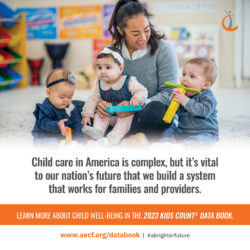
Half of Arkansas’s children are in non-parental care at least 10 hours per week. Before kindergarten, many will spend 11,500 hours in child care and pre-K. That’s more time than they will spend in school from kindergarten through 9th grade.
Early childhood educators are the most important component of quality child care. During those 11,500 hours they are literally shaping children’s brains to become Arkansas’s future students and professionals. But child care programs struggle between the need to pay the wages worthy of building the brains of our future workforce while also knowing all too well that Arkansas families already struggle to pay for child care at current market rates.
Data from the 2023 KIDS COUNT® Data Book release shows us that the hourly median wage for early childhood educators in 2022 was $12.36—hardly a living wage for such a critical job. We have complimentary data from the 2022 UAMS Early Childhood Workforce study that shows that despite the complex needs of children younger than age 3, teachers of infants and toddlers make about $3,500 less per year than colleagues in older classrooms. And although 77% of Arkansas’s early childhood educators work full time, many still do not earn enough to pay for basic necessities. In the past year, 40% of current teachers had trouble paying for food, and 50% of early childhood educators reported having trouble paying for their basic household expenses, such as rent, utilities, and transportation.
We also know that the early childhood workforce is reporting a high level of turnover, as many teachers are both new to the field and at-risk to leave. This higher level of turnover is directly related to the lower pay and fewer benefits, food and economic insecurity, a higher risk for depression, and limited organizational support for professional development. High turnover means children often have less stability in their caregiving relationships. Also, caregivers who are less experienced and less educated may be less equipped to care for children.
This year’s Data Book also takes a look at the average cost of child care for infants and toddlers in Arkansas.
- The average annual price of center-based toddler care in 2021 was $6,806
- This amounts to 24.9% of the median income for a single mother family (whose median income was $27,325)
- This amounts to 7.8% of the median income for a married couple with children (whose median income was $87,059)
- The average annual price of family child care for a toddler in 2021 was $5,482
- This amounts to 20.1% of the median income for a single mother family (whose median income was $27,325)
- This amounts to 6.3% of the median income for a married couple with children (whose median income was $87,059)
From the data on the cost of child care we can see that in Arkansas, availability and accessibility are greater problems than affordability. Even though other states have much higher costs, Arkansas families struggle just as much or more to find child care. Something else to keep in mind is that it is especially difficult to balance the budget of a child care program when caring for infants and toddlers, because the costs are higher for programs to care for younger children. That is a big contributing factor to why we are seeing a lack of options for Arkansas families.
When I talk with families and advocates across the state about the accessibility of child care, I like to ask the following questions to understand the root of their issue:
- Is there not a slot available for your child in your area?
- This is very likely to be the case if they are looking for child care for infants and toddlers.
- Is there is not a slot available in your area that you can afford?
- An ideal percentage of a family’s household budget is 7% for child care. Most middle-income and single-income families will be paying substantially more than 7%.
- Is there not a slot available in your area that you are comfortable leaving your child?
- This gets at the issue of quality. Minimum licensing standards target health and safety practices, and quality standards are layered on top of those. Meeting the minimum licensing standards does not ensure quality components that are more closely tied to learning standards. And again, we can see how the quality of early childhood education is compromised by low teacher compensation.
It is important to make these distinctions because solving each of those scenarios would lead to different solutions.
Lastly, from the KIDS COUNT Data we are seeing that about 32,000 or 14.8% of Arkansas families with children from birth to 5 experienced someone in the family quitting a job, not taking a job, or greatly changing their job because of problems with child care from 2020-2021. This puts us in the top five states in the nation.
This is in line with research from the U.S. Chamber of Commerce Foundation, the Arkansas State Chamber of Commerce, and Excel by Eight Foundations, which showed that absences and employee turnover cost employers $665 million per year, and an estimated $200 million in tax revenue is lost annually due to child care issue. These results demonstrate that child care is indisputably a workforce and economic issue.
Until our state chooses to invest in child care programs, we will continue to find ourselves in a loop where the only solution to improving access is either to ask families to pay more for child care or continue to underpay the early childhood workforce, both of which are unsustainable. State investment in child care can help us break this cycle and propel Arkansas back into being a leader in early childhood education.
